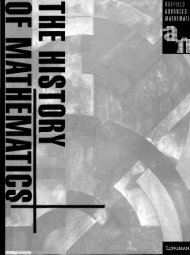UNESCO resource kit - science and technology educa...
UNESCO resource kit - science and technology educa...
UNESCO resource kit - science and technology educa...
You also want an ePaper? Increase the reach of your titles
YUMPU automatically turns print PDFs into web optimized ePapers that Google loves.
<strong>UNESCO</strong> Module 25: Underst<strong>and</strong>ing eclipses of the Sun r -----------------<br />
More eclipse ideas<br />
This picture was drawn in the sixteenth century. It<br />
shows how an eclipse.of the Sun happens when the<br />
Moon blocks off the Sun's light.<br />
People understood eclipses over 2000 years ago,<br />
<strong>and</strong> they were able to predict when an eclipse<br />
would happen. But later; in the Middle Ages, this<br />
knowledge was forgotten. When an eclipse<br />
happened, people were taken by surprise. They<br />
thought that the gods were displeased, <strong>and</strong> that<br />
some dreadful fate was about to befall them.<br />
In the sixteenth <strong>and</strong> seventeenth centuries, European scientists worked out the<br />
details of the planets' orbits round the Sun. They saw the planets as bodies<br />
m.oving with the precision of clockwork. Eclipses could be predicted to the<br />
minute <strong>and</strong> were anticipated with great excitement by astronomers <strong>and</strong> the<br />
<strong>educa</strong>ted people of the towns. Here is what someone wrote about the total solar<br />
eclipse of 8 April 1652:<br />
"The country people tilling loosed theirploughs. The birds dropped to theground. //<br />
And here is what Francis Baily, an English astronomer, wrote in his account of<br />
the total eclipse of 1842:<br />
/7was astounded by a tremendous burstofapplause from the street below: <strong>and</strong> atthesamemomentwaselectrified atthe<br />
sightofoneofthemostbrilliant<strong>and</strong> splendid phenomena thatcan be imagined, for that instant the dark body of the Moon<br />
was suddenly surrounded with a corona/akind of bright glOly fa saintly halo/ aspainted by medieval artists} ....But the<br />
mostremarkablecircumstanceattendingthe phenomenonwastheappearanceofthreeIargeprotuberancesapparently<br />
emanating from the circumference of the Moon but evidently forming aportion of the corona.//<br />
Page 4<br />
Baily had read many eyewitness accounts of eclipses, but this was the first one<br />
he had seen for himself. He had not anticipated anything so magnificent. At the<br />
same time, he declared that there was /I something in its singular <strong>and</strong> wonderful<br />
appearance that was appalling."<br />
Another astronomer, Francois Arago, observed the same eclipse in the south of<br />
France. A murmur of excitement built up as totality approached, to be replaced<br />
by a profound calm. As the Sun returned it was greeted with /I transports of joy<br />
<strong>and</strong> frantic applause." Eclipses had become a spectacle of great public interest,<br />
<strong>and</strong> they still are today ..<br />
1 Look at the picture at the top of the page. Identify the Sun, the Moon <strong>and</strong><br />
the Earth. Find the Sun's rays <strong>and</strong> the shadow of the Moon. Did the artist<br />
underst<strong>and</strong> why eclipses happen?<br />
2 Find out about the Sun's corona. Today, we call the 'protuberances' which<br />
Francis Baily saw 'prominences'. What are they? Do they come from the<br />
Moon or the Sun?<br />
.3 How have people's reactions to eclipses changed in the last 2000 years?

















